PWA’s or Progressive Web Apps are one of the ways to load apps a lot faster and work almost like native apps installed on Windows. Both Chrome and Edge support PWA, and you can launch apps when you start Chrome or Edge. It is especially useful when you use a set of websites often, and they offer PWA. That said, while PWA provides an advantage over software, but it does not automatically launch.
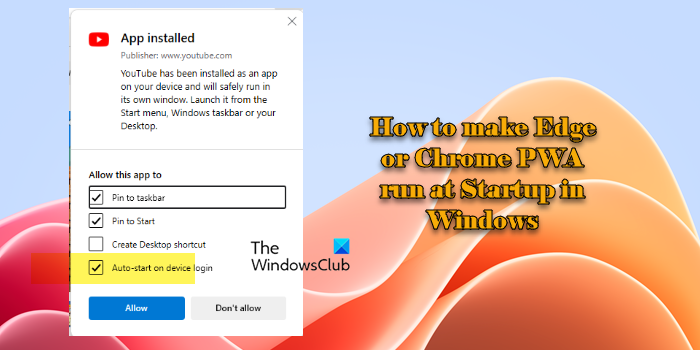
To resolve this, Chromium Engine has received an update that allows both Edge and Chrome PWA to run at Startup in Windows 11/10. You can think of them as a dedicated app that can place them in the Windows Startup.
Make PWAs run automatically at Startup in Windows
This feature allows you to launch PWA-enabled websites as apps along with Windows. If you do not want a full browser experience with some of the sites and work with them as soon as you log in to the computer, this is an excellent option.
Enable Chrome PWA Run at Startup flag

- Open Chrome, and type the following in the address bar.
chrome://flags/#enable-desktop-pwas-run-on-os-login
- Click on default in the dropdown, and change it to Enabled.
- Restart Chrome
- Then go to the website which offers PWA. I am taking Twitter as an example.
- Click on the Install link that shows up at the end of the address bar.
- It will prompt if you want to install it, and also offers you the option to launch it as you sign in.
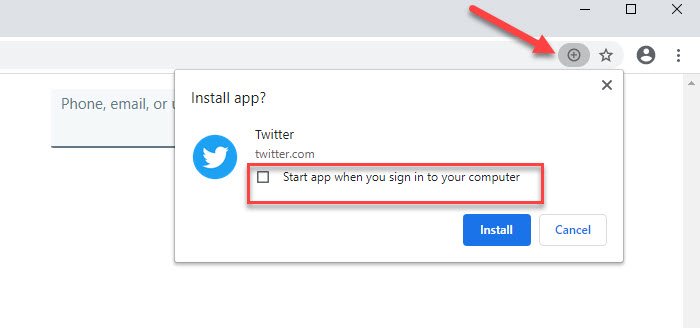
The setting is also called Desktop PWAs run on OS login. It enables installed PWAs to be configured to start when the OS user logs in automatically. – Mac, Windows, Linux, Chrome OS.
TIP: This post will show you how to open Microsoft Store apps on startup.
Enable Microsoft Edge PWA Run at Startup flag
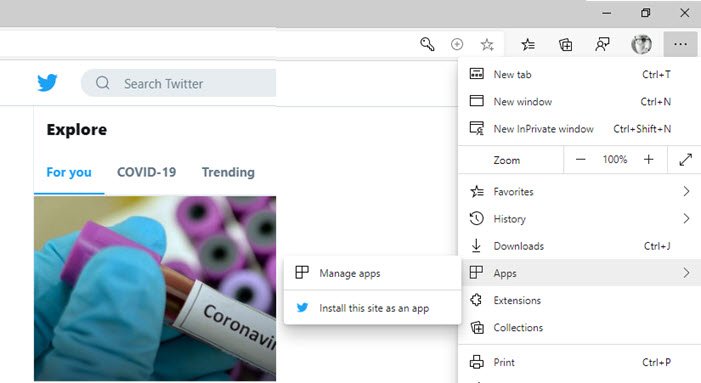
- Launch Microsoft Edge
- Open a new tab, and enter the following settings.
edge://flags/#enable-desktop-pwas-run-on-os-login
- Enable the Desktop PWAs to run on OS login flag
- As an example, open Twitter.com on the Edge.
- Click on the three-dotted menu, then on Apps, and select Install this site as an app.
- Similar to Chrome, you can choose to select—Start app when you sign-in to the computer.
How does Desktop PWAs run on OS login work?
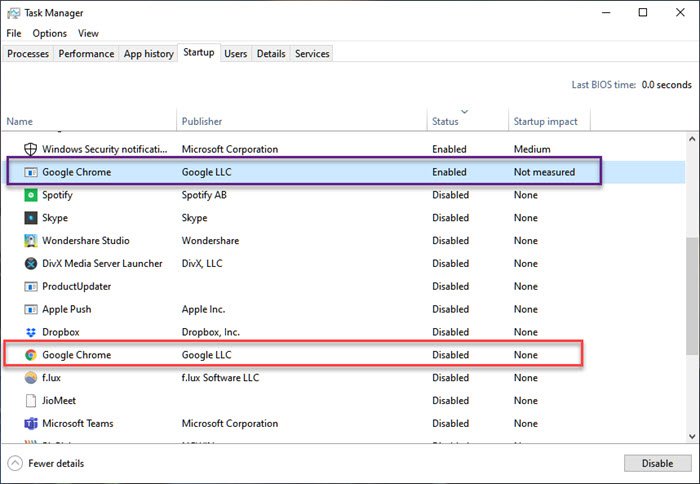
When you reboot the computer next time, the app launch automatically, even if you have Chrome or Microsoft Edge, is disabled. That’s where things get interesting. Since Windows treats this as an application, it gets its entry in the Startup.
Right-click on the taskbar and select Task Manager. Next, switch to the Startup tab, and notice there is an extra entry of Chrome or Microsoft Edge under the enabled section. Ideally, it should have used the app name, in this case, Twitter, but at least for now, it will only show Google or Chrome as the name.
This feature is available in the Canary version of the browsers, and will soon appear in the final version.
Make PWAs run automatically at Startup using the ‘Run on login’ feature
Update: These flags are no longer available. However, on the latest Chrome and Edge versions, you may configure a PWA to automatically start on OS login using the ‘Run on login’ feature. The feature is designed to improve the startup experience by allowing certain apps and websites to launch automatically when you log into your computer.
‘Run on login’ is available in Chrome 91 or Edge 91 or later, on Windows 11/10.
Open your browser and type about://apps in the address bar. Press the Enter key. You will see the list of progressive web apps that you’ve installed in Google Chrome/Microsft Edge.
In Google Chrome, right-click on the desired app and check the box for ‘Launch at startup’ to enable the setting.
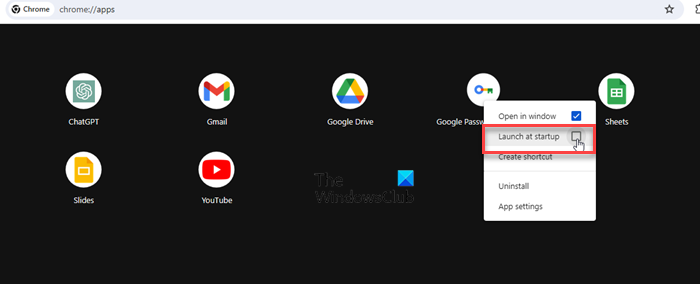
In Microsoft Edge, click the More options icon (three dots) next to the app’s name under Installed apps. Click on the ‘Auto-start on device login’ option. You might also see an option or a prompt asking if you want the app to run automatically when you log in while installing a PWA in the Edge browser.
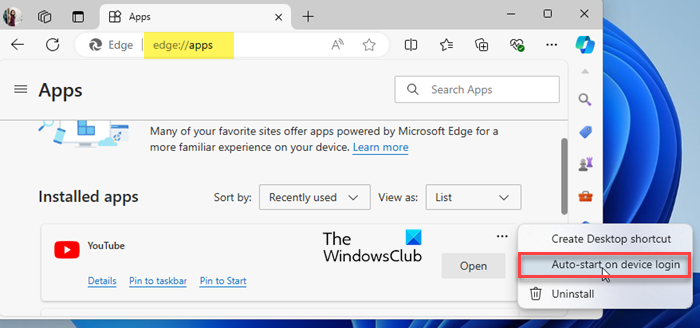
Exit Chrome/Edge and restart the browser for the changes to take effect.
Now, every time you start your computer and log into Windows, the app will automatically open, saving you the step of manually launching it.
If you have any queries or doubts, please share them in the comments section below.
Read: How to make a Program run on startup in Windows.
How do I make Chrome open on startup Windows 11?
Several methods allow you to make Google Chrome run on startup in Windows 11. Press Win + R to open the Run dialogue. Type ‘shell:startup’ and press Enter. This will open the Startup folder. In the Startup folder, right-click and select New > Shortcut. In the location field, enter the path to the Chrome executable (C:\Program Files\Google\Chrome\Application\chrome.exe) Click Next, then give your shortcut a name (e.g., Google Chrome). Click Finish. Chrome will now launch automatically when you start your computer. Advanced users may use Registry Editor to make Chrome run on Startup in Windows.
How do I make Microsoft Edge run automatically at startup?
To make Microsoft Edge run automatically at startup on a Windows 11/10 PC, open the Settings app by pressing the Win + I keys together. Then click Apps in the left panel of the Settings window. Click Startup in the right panel (the last option from the bottom). Locate Microsoft Edge in the list of available apps and turn on the toggle button present next to the app’s name. You’ve configured Microsoft Edge to start when you log in to your Windows PC.
Read Next: Remove dead Startup programs or Invalid entries from Task Manager.
Leave a Reply